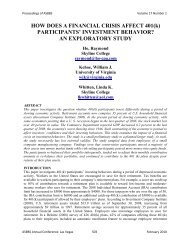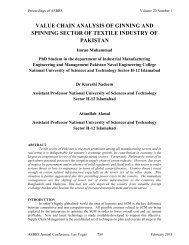stock repurchase announcements: a test of market ... - Asbbs.org
stock repurchase announcements: a test of market ... - Asbbs.org
stock repurchase announcements: a test of market ... - Asbbs.org
Create successful ePaper yourself
Turn your PDF publications into a flip-book with our unique Google optimized e-Paper software.
Walecki<br />
the impact <strong>of</strong> industry clusters are nowhere to be found in this important book. As a result<br />
concepts such as firm and industry location, agglomeration and localization economies, and even<br />
clusters are little known to many business and economics graduates.<br />
However, in recent years there have been some encouraging signs that may change the way<br />
academia, as well as private and public <strong>org</strong>anizations, look at business and economic growth.<br />
New powerful voices, including prominent economists such as Paul Krugman and Michael<br />
Porter, have been raised since 1990s to highlight the importance <strong>of</strong> geography in economic<br />
development. Krugman initially started warning us that even international trade theory could not<br />
be complete without including economic geography (Krugman, 1991b). His more recent work<br />
together with Fujita has focused on re-defining the role <strong>of</strong> geographic space through the ‘new<br />
economic geography’ (Fujita & Krugman, 2004). At the same time, Michael Porter in his quest<br />
for causes <strong>of</strong> increased competitiveness has also discovered the importance <strong>of</strong> geography, firm<br />
location, and especially clusters to business and economic development, whether at the regional<br />
or national levels (Porter, 1998a & 2000b). Today, there are many more pr<strong>of</strong>essionals and<br />
academics supporting an unprecedented increase in the study <strong>of</strong> the role <strong>of</strong> geographic space in<br />
business growth and economic expansion.<br />
ECONOMIC VERSUS GEOGRAPHIC SPACE<br />
For the purpose <strong>of</strong> this paper geographic space is defined as the actual physical space in which all<br />
economic activities take place and the allocation <strong>of</strong> resources is decided by the main economic<br />
players, i.e. individuals/ households, firms and governments. The full understanding <strong>of</strong> the role<br />
<strong>of</strong> a given geographic space, such as a region, cannot be limited to traditional factors based on<br />
transportation costs, or a mere accounting <strong>of</strong> natural resources, current factor endowments, and<br />
even an existing infrastructure and externalities. It must be supported by a full assessment <strong>of</strong> the<br />
role <strong>of</strong> physical environment and should consider potential factor shifts and future trends that will<br />
impact the region, including changes in its comparative and competitive advantages. On the other<br />
hand, economic space is determined by factors related to business environments and economic<br />
relations and exchanges that take place between economic agents. The size <strong>of</strong> economic space <strong>of</strong><br />
a firm is not fixed and continues to change as businesses grow and decline. Following business<br />
expansion within its economic space, its geographic space may also expand, but it could also stay<br />
the same or even contract. One <strong>of</strong> the currently available technical tools that allows better<br />
bridging <strong>of</strong> economic and geographic spaces is the Geographic Information Systems (GIS).<br />
Most economists have traditionally devoted their main attention to the study <strong>of</strong> relationships<br />
within economic spaces, <strong>of</strong>ten defined along the sectoral or industrial boundaries, while the<br />
treatment <strong>of</strong> geographic space has been largely absent from their considerations. In the past only<br />
a very limited number <strong>of</strong> economic studies took on spatial dimensions more seriously. At present<br />
new theoreticians in addition to Krugman and Porter are slowly changing old perceptions.<br />
McCann insists that economics must consider geographical and sectoral factors if the field is to<br />
explain industrial location (McCann, 2002). Behrens and Thiesse emphasize that any analysis <strong>of</strong><br />
regional issues must recognize differences between spatial units and it requires the minimum <strong>of</strong><br />
two regions (Behrens and Thiesse, 2007).<br />
Geographic and economic spaces have different meanings to governments and businesses. While<br />
firms have a lot more freedom in terms <strong>of</strong> their spatial behavior, most governments face serious<br />
spatial limitations as they are restricted by their limited geographic and economic spaces. Those<br />
geographic spaces are usually constant with very few exceptions, mostly available to regional and<br />
local governments, such as expanding into previously unincorporated areas, acquiring additional<br />
land that could be developed, or discovering new natural resources. In most cases, a limited<br />
ASBBS E-Journal, Volume 4, No.1, 2008 178

















